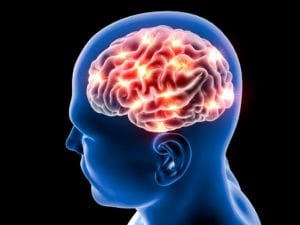Written by Joyce Smith, BS. This study suggests that extremely low-frequency electromagnetic field, through the production of nitric oxide can help regulate inflammation and oxidative stress levels to improve recovery of brain injury following stroke.
 Stroke is a leading cause of morbidity and mortality as well as long-term disability. It affects 795,000 people every year and with 185,000 recurrent strokes, the annual cost of stroke to the United States government is $34 billion annually. This cost includes the cost of health care services, medications, and lost productivity 1.
Stroke is a leading cause of morbidity and mortality as well as long-term disability. It affects 795,000 people every year and with 185,000 recurrent strokes, the annual cost of stroke to the United States government is $34 billion annually. This cost includes the cost of health care services, medications, and lost productivity 1.
The neurotransmitter, Nitric oxide (NO), is one of the most important signal molecules and actively participates in both physiological and pathological processes 2,3. It functions as a potent vasodilator, increasing cerebral blood flow, neurogenesis, and synaptic plasticity. However 4, at high concentrations, NO can promote inflammation and play a role in many neurological diseases such as depression, schizophrenia, epilepsy, anxiety, and drug addiction 4. Neuroplasticity is the brain’s ability to form and reorganize synaptic connections, especially in response to learning or following an injury. While the process is not yet fully understood, neuroplasticity plays an important role in the recovery of the injured brain in those who have had a stroke. 5. This study 6 was designed to investigate the impact of an extremely low-frequency electromagnetic field (ELF-EMF) on the generation and metabolism of NO, as a neurotransmitter, in the rehabilitation of acute post stroke patients.
Forty-eight patients were divided into two groups: ELF-EMF and non-ELF-EMF. Both groups underwent the same 4-week rehabilitation program in a General Hospital in Poland; while the ELF-EMF group was exposed to an extremely low-frequency electromagnetic field of 40 Hz, 7 mT, for 15 min/day. Whole blood samples were collected to measure blood plasma levels of 3-nitrotyrosine, nitrate/nitrite, and TNFα. NOS2 gene expression was also determined. The Activity Daily Living (ADL), Geriatric Depression Scale (GDS), and Mini-Mental State Examination (MMSE) were used to evaluate functional status both before and following a series of ELF-EMF treatments.
Following the 1-week ELF-EMF treatment protocol, researchers noted an increase in nitric acid production and its metabolism which improved the effectiveness of the treatments. They attributed the improvement to the vasodilating and proangiogenic effects of nitric oxide. Levels of 3-nitrotyrosine (3-NT) increased significantly, and concentrations of nitrate/nitrite increased significantly [68% versus 17%; (p<0.05) and (p<0.01 respectively] in the ELF-EMF group while expression of NOS2 decreased in both groups but not significantly. Proinflammatory cytokine tumor necrosis factor alpha (TNFα) was unchanged.
Motor abilities, measured by ADL, improved in both groups (p<0.001); MMSE significantly improved in the ELF-EMF treated group (p=0.002); and depression, measured by GDS, significantly decreased in both groups. However, in the ELF-EMF group, depression was 60% lower than in the non-treated ELF-EMF group (p=0.018) in spite of having similar base levels.
The authors conclude that ELF-EMF therapy increases the metabolism and generation of NO, which can function as both a neuroprotective and cytotoxic agent. In this study ELF-EMF therapy increased the metabolism and generation of N0 which increased blood flow and promoted the development of new blood vessels in the injured post stroke brain of study participants
Source: Cichoń, Natalia, Piotr Czarny, Michał Bijak, Elżbieta Miller, Tomasz Śliwiński, Janusz Szemraj, and Joanna Saluk-Bijak. “Benign effect of extremely low-frequency electromagnetic field on brain plasticity assessed by nitric oxide metabolism during poststroke rehabilitation.” Oxidative medicine and cellular longevity 2017 (2017).
© 2017 Natalia Cichoń et al. This is an open access article distributed under the Creative Commons Attribution License, which permits unrestricted use, distribution, and reproduction in any medium, provided the original work is properly cited.
Click here to read the full text study.
Posted April 23, 2019.
Joyce Smith, BS, is a degreed laboratory technologist. She received her bachelor of arts with a major in Chemistry and a minor in Biology from the University of Saskatchewan and her internship through the University of Saskatchewan College of Medicine and the Royal University Hospital in Saskatoon, Saskatchewan. She currently resides in Bloomingdale, IL.
References:
- Benjamin EJ, Blaha MJ, Chiuve SE, et al. Heart Disease and Stroke Statistics-2017 Update: A Report From the American Heart Association. Circulation. 2017;135(10):e146-e603.
- Rasool M, Ashraf MA, Malik A, et al. Comparative study of extrapolative factors linked with oxidative injury and anti-inflammatory status in chronic kidney disease patients experiencing cardiovascular distress. PLoS One. 2017;12(2):e0171561.
- Kozlov AV, Bahrami S, Redl H, Szabo C. Alterations in nitric oxide homeostasis during traumatic brain injury. Biochimica et biophysica acta Molecular basis of disease. 2017;1863(10 Pt B):2627-2632.
- Lei J, Vodovotz Y, Tzeng E, Billiar TR. Nitric oxide, a protective molecule in the cardiovascular system. Nitric Oxide. 2013;35:175-185.
- Klarner T, Barss TS, Sun Y, Kaupp C, Loadman PM, Zehr EP. Long-Term Plasticity in Reflex Excitability Induced by Five Weeks of Arm and Leg Cycling Training after Stroke. Brain sciences. 2016;6(4).
- Cichon N, Czarny P, Bijak M, et al. Benign Effect of Extremely Low-Frequency Electromagnetic Field on Brain Plasticity Assessed by Nitric Oxide Metabolism during Poststroke Rehabilitation. Oxid Med Cell Longev. 2017;2017:2181942.
